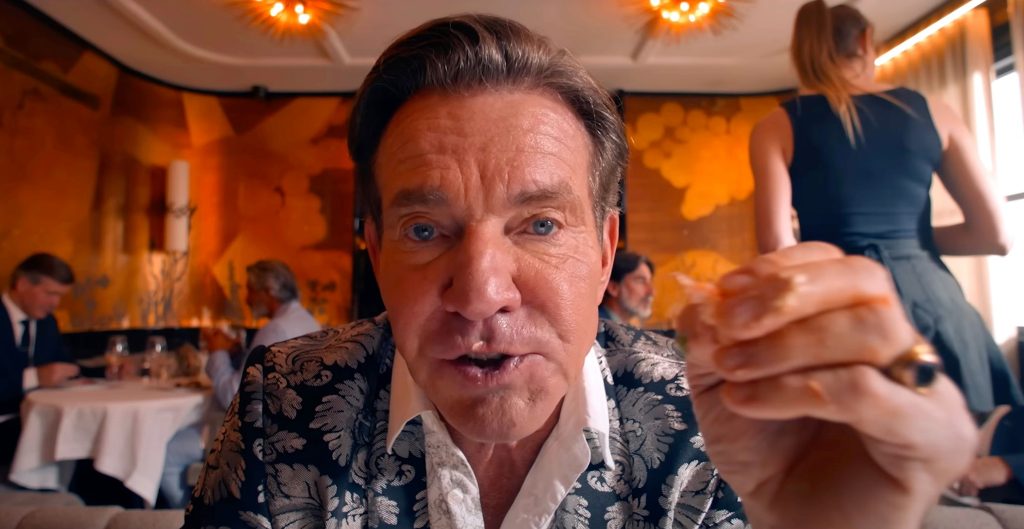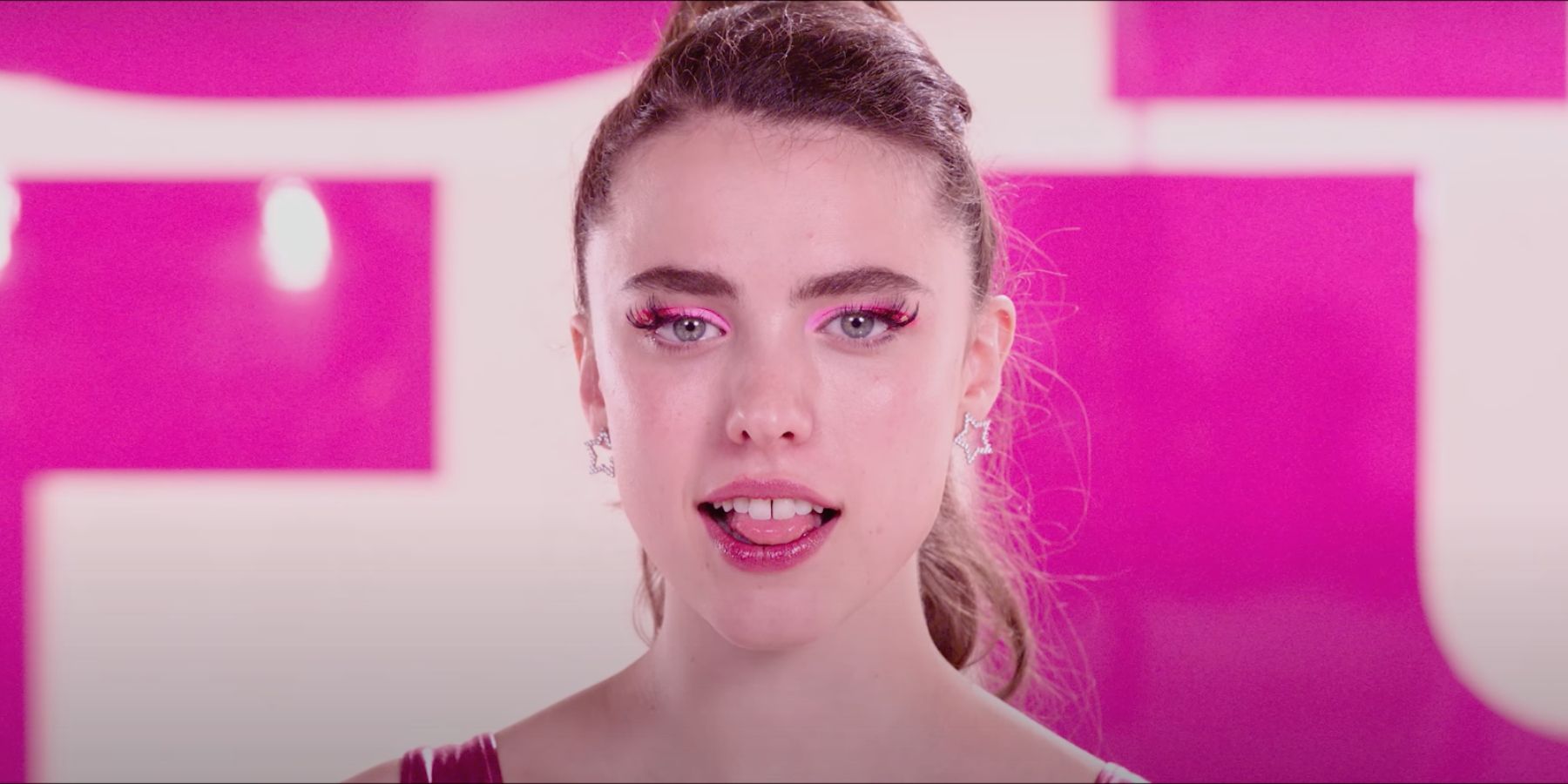What makes a successful horror film? Is it just blood and mayhem or is there more to it?
The Substance, written and directed by Coralie Fargeat, is a master class in how to do a great horror movie, one with tragic resonance, and power.
Background
An aging actress, Elisabeth Sparkle (Demi Moore) who is a world standard for beauty and desirability, overhears the producer of her hit workout show on the phone talking about how old she is and directing the person on the phone to find someone younger. In our youth-obsessed culture this hits hard and causes Elisabeth to panic. In desperation, she decides to partake of the mysterious ‘substance’ which will create a younger self, separate but never really separate, from her current self.
Let the mayhem begin.

Coralie Fargeat. Photo by Rocco Spaziani
Rules
Good horror – any story really – functions under a set of rules to create suspense. In this case, there are some creepy, odd ones and violating them leads to horrific (of course) consequences.
Elisabeth is informed:
At the bottom of the box, a small white note card with
instructions and icons:
«YOU ACTIVATE» – only once (intravenous)
«YOU STABILIZE» – everyday (intramuscular)
«YOU SWITCH» – every 7 days without exception.
She turns the card over and reads the inscription on it:
REMEMBER YOU ARE ONE
She’s also given special food for herself and “The Other.”
Notice the use of “The Other”, an alien/supernatural reference. Ms Fargeat never misses a chance to infuse/ overlay this film with sly references that surround the storyline. There are many nods to classic horror films in this one.
Once Elisabeth makes the decision to do this, a second her, much younger, explodes out of her back. Once born, Sue (Margaret Qualley) sews up the back of the unconscious Elisabeth and hides her in a secret room.
Solid Narrative Thread
The Substance has a compelling story as Sue becomes the new face of the workout show. It’s a slow ascension to superstardom and also a slow burn to upping the stakes as it goes.
Sue falls in love with the glamor and power (how can you not?) as Elisabeth increasingly becomes bothered by the fact that her younger self is on the ascendancy of stardom. Part of this is the lack of love the older Elisabeth is given which taps into the character’s ego. She’s yesterday’s dried up meal; an afterthought at this point. No one is calling her, offering her jobs, or telling her she’s the prettiest girl in the world – that’s now all Sue’s. And Elisabeth can’t handle it. A giant billboard outside her window of Sue mocks her constantly.

Harvey (Dennis Quaid) Photo courtesy of TUBI
This allows for a constant drumbeat of resentment to build in the storyline until it reaches and goes wildly beyond a climax.
Theme
The themes in this movie could encompass an entire book itself. But let’s focus on two:
Ego: Without a doubt the strongest theme in the literary universe. Frankenstein, Alien, The Thing, The Fly, etc. All focus on the folly of humankind’s unholy but human desires. Here it’s obvious, almost a cliché of Hollywood – aging means less of everything.
Plastic surgery, weight-loss drugs, even recreational drugs infect every aspect of our lives in an attempt to modify our lives and Hollywood is even more so. Move aside, the industry seems to always say, we want the next, better, younger version.
Internal Horror: Although Hollywood is probably the worst offender and we can say to ourselves, “that wouldn’t be me” that nagging voice in our heads warns us that younger versions of the workforce, any workforce, seems to value youth against experience. The latest 19-yr-old suddenly appears at the desk next to yours and the writing on the wall is clear.
Good horror films thematically reflect both society and our own internal fears.
Satire
Hand-in-hand with the thematic overlays in The Substance is the world vision.
Satire, which exaggerates a situation for effect, is a tried and true sub-genre to include outrageous moments. Fargeat knows and embraces this story-telling method with masterful glee to create some of the most challenging moments in film.
Pushing limits, which satire does very well, is deeply infused in the DNA of this movie. Besides the obvious gross and bloody moments, the in-your-face shots of Sue’s lower body parts, for example, are just a small part of Fargeat’s satirical delivery.
Thin WAISTS and PELVISES sway suggestively.
SUPER HIGH CUT flashy leotards, reveal perfectly waxed groins
underneath –
Firm and BOUNCY BOSOMS compressed inside the Lycra.
Close up shots of Harvey, Dennis Quaid’s character’s disgusting eating (symbolic of corporate greed) and his consistently overly-exaggerated demeanor continue to bolster the satirical nature of the film.

Sue Sparkle (Demi Moore) Photo courtesy of TUBI
Sexuality
Sex is universal. Solid horror gives the audience one of the tropes it craves in horror – nudity. Yes, okay, not every horror film has nudity, but many of them do. We’re exposed and vulnerable. It’s part of the peek-through-the-keyhole, voyeuristic nature of the genre. Fargeat knows this and delivers.
Fargeat takes the nudity one thematic step further as part of the body-image theme that infuses the storyline. We are our own worst critic, and in one scene a naked Elisabeth studies herself in the mirror focusing on any minor flaws or imperfections. It’s motivation for the character and speaks loudly without dialogue to her inner thoughts.
We, the audience, have to be as critical of Elisabeth’s body as much as the main character herself in order to understand her motivations but we’re also following the camera as it scans her, judging. How many of us look in the mirror and wish we saw something different, better? The nudity allows us to relate to this scene on many levels.
Gore
Blood, blood, and more blood. Fargeat puts Rob Zombie to shame with her use of grotesquerie and blood effects.
The moments of the Sue creature evolving into something horrible, the disgusting sounds Dennis Quaid’s character makes while eating, Sue’s horrifying loss of teeth and nails, Elisabeth’s binging food – there isn’t a point where you’re free from visual, auditory, or intellectual gore which suffuses the entire film with constant tension and repellent moments.
In an ending scene, the twisted creature that MonstroElisaSue has become sprays an audience with massive amounts of blood.
Everyone is sprayed with the blood now gushing out of her arm
stump, like a snow canon.
She sprays blood in every direction, like a lawn hose, while
spinning around in her princess dress.
Of this scene, which took 36,000 gallons of fake blood, Fargeat says, “All the violence that you project on me, the monster, at some points, it’s projected back on the audience, which is all of us.”
The final creature is a disgusting masterpiece of mismatched body parts like a breast attached to an optic nerve that falls out of an eye socket. But, again, it has purpose. Beyond any beauty standard, the creature MonstroElisaSue at this point is finally free from judgment.
Violence
The movie delivers in all aspects like any traditional horror film. There’s emotional, mental, physical, and societal violence aplenty to keep this delivering constantly on gut-churning tension.
A fight scene between Elisabeth and Sue is as violent as any John Wick film.
Suspense
Likewise, the suspense is ever-present and always building. The film never relaxes because there’s this body in the hidden room – sometimes Sue, sometimes Elisabeth – that may at any moment spring out at us. Like a Frankenstein monster, reflecting the creator’s flaws, the Other is there and will always be an unknown element.
Plus, technique-wise, there is a perfect pacing to the building of this suspense and violence. The story narrative supports the success of every three-act structure which, despite the trendy criticism against it, is perfect to push a story along certain pathways to deliver on maximum suspense.
Ending
The MonstroElisaSue created in the last act is reminiscent of the movie The Elephant Man. You can almost hear John Merrick (John Hurt) shouting , “I am a man not a monster!” as she looks out over an audience there to see Sue twinkle as the latest ascending star.
But she’s horrible. A pastiche of two bodies slap-hazardously melded together, leaking fluids, twisted into a barely recognizable human shape. The pathos is throat catching, palpable. This is powerfully emotional and visceral.
Monsters dying in the end of horror tales is appropriate. Feeling sorry for them is rare indeed. The Frankenstein monster’s ending in the original book is one of emotional pain and isolation. The best of the best in horror makes you feel similarly sorry for the creature who just moments ago was wreaking havoc on the population.
As MonstroElisaSue sprays blood on the audience and then drags herself up Hollywood Blvd to die on her star, we cringe at her horrible appearance but as she dies our hearts elevate a little because she’s finally free of the true horror of this film – the unrealistic beauty standards we’ve enforced on ourselves.

